〈Background〉
In Laos, slope pavement has been the only solution to the erosion of the shoreline of the Mekong that occurred due to annual flooding. The scour of the base has frequently induced the entire pavement to settle or collapse causing great damage. The country with a low financial capacity (annual public utilities project budget: 2.7 million dollars) has inadequate funds for importing materials from abroad that are required for remedial measures. Routes for transporting materials and equipment for large-scale construction have yet to be built.
The revetment construction method applicable to the country, should be sufficiently flexible for countering the deformation of the ground. The availability of materials and the construction cost are the key factors. To meet such requirements, the traditional river channel improvement methods that used to be employed in Japan have been gathering attention.
The traditional methods are also expected to help deal with poverty because the acquisition of materials may lead to the creation of local job opportunities.
|
1.Profile of the Mekong River
Catchment area: 790,000 km2, Length of the river channel: 4,620 km
Catchment area around Vientiane: 270,000 km2
Maximum annual flow: 16,000 m3/sec, Minimum annual flow: 1,000 m3/sec, Head: Approximately 10 m
Bed slope: 1/12,000, Maximum velocity: Approximately 3 m/sec (during the wet season), Mean velocity: Less than 2 m/sec
Wet season: May through October, Dry season: November through April, Annual precipitation: 1,700 mm
|

Source: Hiroshi Hori, The Mekong:Development and the Environment, 1996
|
| 2. History |
| 1990 |
Construction Bureau of Vientiane municipal government started construction of revetments with foreign financial aid. |
| 1998 |
Laotian government installed spur dikes in Bokeo Province in cooperation with JICA's local experts. |
| Jan. 1999 |
Ministry of Construction of Japan and Infrastructure Development Institute, Japan (IDI) conducted field surveys and held a revetment technology seminar. |
| Dec. 1999 |
IDI had fascine craftspeople of Japan made field investigations of materials in Laos. |
| Aug. 2000 |
IDI trained three Laotian engineers on fascine mattresses in the Shinano River. |
| Nov. 2000 |
through Feb. 2001: IDI installed fascine mattresses in the Mekong on a trial basis. |
| Until Mar. 2003 |
IDI monitored the construction of fascine mattresses. |
 |
| July 2001 |
JICA conducted feasibility studies. |
| Dec. 2001 |
through Mar. 2005: JICA conducts development surveys, carries out test construction of fascine mattress and other types of structures, and prepares a master plan. |
|
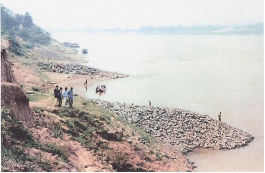 3. Installation of spur dikes in Bokeo Province 3. Installation of spur dikes in Bokeo Province
Rate of shoreline retreat: More than 20 m in the past two decades
Bed slope: 1/2,500, Channel width: 400 m
Annual head: 10 m, Maximum velocity: 3 m
The Laotian government planned to construct revetments with gabions and counted on foreign aid. At the guidance of JICA experts, spur dikes were constructed using the granite that was available locally.
Length from the shoreline: 40 m, Interval: 100 m, Height: 6 m (local willow is expected to grow on the spur dikes), Gradient at the tip: 1:3, Gradient at upstream end: 1:1.5, Gradient at downstream end: 1:3
Cost of spur dikes: 50,000 yen/m (cost of gabion revetment: 200,000 yen/m)
Sediments tend to be deposited between spur dikes. Riparian areas are now easier to use.
|
4. Test construction of fascine mattresses (IDI)
The applicability of fascine mattresses to the foundation or foot protection work was examined.
Site: Vientiane city, Length: Approximately 80 m (gabion mattresses: 30 m, fascine fences: 50 m)
Twelve fascine mattresses 8 m x 6 m were buried at the toe of the revetment and four fascine mattresses 10 m x 6 m were buried as spur dikes.
|
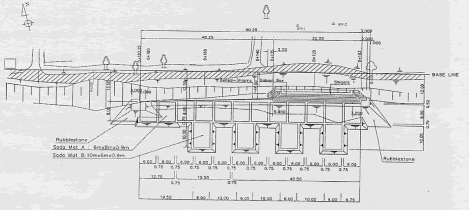
Plan of test construction of fascine mattresses
|
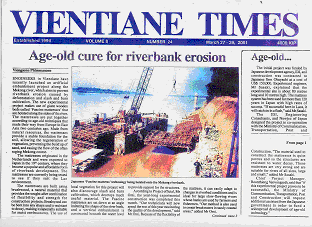 |
Fascine mattress construction reported in Vientiane Times |
|
5. Investigations for rivebank erosion control in the Mekong near Vientiane in Laos
Preliminary investigations were conducted in July 2001, and full-scale investigations in December 2001 through March 2005.
(1) Objectives of investigations
To assess erosion control methods to find a low-cost method practicable in Laos using the traditional river channel improvement methods of Japan.
To transfer technology through pilot construction work
To prepare a master plan based on the monitoring during the pilot construction
(2) Pilot construction planned at present
Fascine mattresses: Construct fascine mattresses downstream of the site where IDI installed spur dikes near Vientiane, to reduce cost and continue the transfer of construction technology
Sheet pile groins and revetments with willow trees: Apply them where the hinterland is of low value
Cobblestone wickers: Used as a low-cost substitute for gabions
|
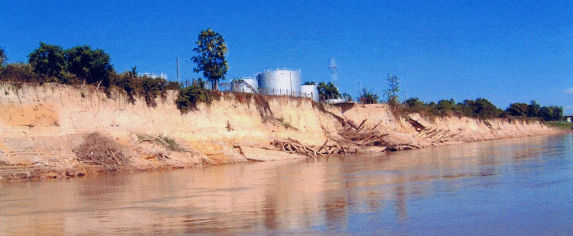
|
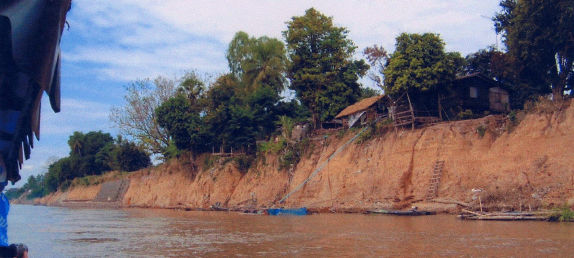
Riverbank erosion at the site where pilot construction is scheduled |